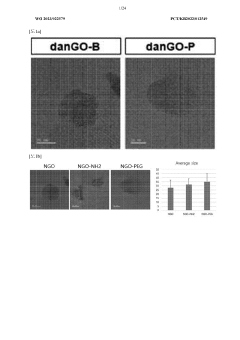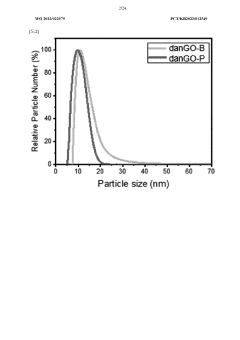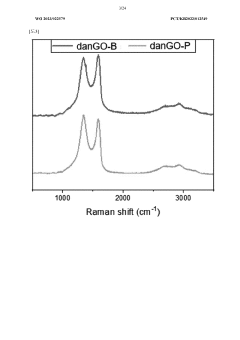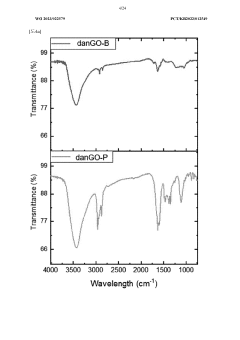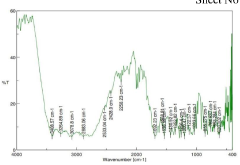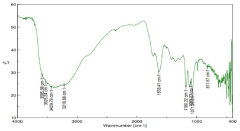Graphene Oxide in Skin Cancer Treatments: Emerging Trends
Graphene Oxide in Oncology: Background and Objectives
Graphene oxide (GO) has emerged as a promising material in the field of oncology, particularly in the treatment of skin cancer. This revolutionary nanomaterial, derived from graphene, has garnered significant attention due to its unique properties and potential applications in cancer therapy. The development of GO-based treatments for skin cancer represents a convergence of nanotechnology and oncology, offering new possibilities for more effective and targeted interventions.
The journey of graphene oxide in cancer treatment began with the discovery of graphene in 2004, which led to an explosion of research into its derivatives and applications. As scientists explored the potential of graphene-based materials, GO quickly stood out for its exceptional characteristics, including high surface area, excellent biocompatibility, and the ability to be functionalized with various molecules. These properties make GO an ideal candidate for drug delivery, photothermal therapy, and biosensing applications in cancer treatment.
In the context of skin cancer, GO offers several advantages over traditional treatment methods. Its ability to penetrate the skin barrier and target cancer cells specifically has opened up new avenues for localized and minimally invasive therapies. The photothermal properties of GO allow for the conversion of light energy into heat, enabling the selective destruction of cancer cells without damaging surrounding healthy tissue. This approach holds promise for reducing the side effects associated with conventional cancer treatments.
The primary objective of research into GO for skin cancer treatment is to develop more effective, targeted, and less invasive therapeutic options. Scientists aim to harness the unique properties of GO to create multifunctional platforms that can simultaneously diagnose, treat, and monitor skin cancer progression. This includes the development of GO-based drug delivery systems that can enhance the efficacy of existing chemotherapeutic agents, as well as novel GO-mediated photothermal and photodynamic therapies.
Another key goal is to improve the early detection and diagnosis of skin cancer using GO-based biosensors. These sensors could potentially detect cancer biomarkers with high sensitivity and specificity, enabling earlier intervention and improving patient outcomes. Additionally, researchers are exploring the use of GO in combination therapies, where it can act as both a therapeutic agent and a carrier for other cancer-fighting compounds.
As the field progresses, there is a growing focus on addressing the challenges associated with GO-based therapies, such as optimizing biocompatibility, enhancing targeting efficiency, and ensuring long-term safety. The ultimate aim is to translate these promising laboratory findings into clinically viable treatments that can significantly improve the prognosis and quality of life for skin cancer patients.
Market Analysis: Skin Cancer Treatment Demand
The global skin cancer treatment market has been experiencing significant growth, driven by increasing incidence rates and advancements in treatment technologies. Skin cancer remains one of the most common types of cancer worldwide, with melanoma being the most aggressive and deadly form. The rising prevalence of skin cancer, coupled with growing awareness and early detection initiatives, has led to a substantial increase in demand for effective treatment options.
In recent years, the market has witnessed a shift towards more targeted and personalized therapies, with immunotherapies and targeted molecular treatments gaining prominence. These advanced treatments have shown promising results in improving patient outcomes and quality of life. The introduction of novel technologies, such as graphene oxide-based treatments, represents a potential paradigm shift in skin cancer management, attracting considerable attention from both healthcare providers and patients.
The demand for skin cancer treatments is further fueled by demographic factors, including an aging population and increased exposure to UV radiation due to changing lifestyle patterns. Developed regions, such as North America and Europe, continue to dominate the market share, owing to advanced healthcare infrastructure and higher awareness levels. However, emerging economies in Asia-Pacific and Latin America are expected to exhibit rapid growth in demand, driven by improving healthcare access and rising disposable incomes.
The market landscape is characterized by intense competition among pharmaceutical companies, biotechnology firms, and research institutions, all vying to develop innovative and more effective treatment modalities. This competitive environment has led to substantial investments in research and development, particularly in areas like nanotechnology-based treatments, including graphene oxide applications.
Despite the growing demand, several challenges persist in the skin cancer treatment market. These include the high cost of advanced therapies, potential side effects of treatments, and disparities in access to care across different regions and socioeconomic groups. Additionally, the complexity of skin cancer biology and the need for personalized treatment approaches continue to drive the search for more effective and less invasive treatment options.
The integration of artificial intelligence and machine learning in skin cancer diagnostics and treatment planning is emerging as a significant trend, potentially enhancing early detection rates and treatment efficacy. This technological advancement, combined with the promise of novel materials like graphene oxide, is expected to reshape the skin cancer treatment landscape in the coming years, potentially addressing some of the current market challenges and unmet patient needs.
Current Challenges in Graphene Oxide-based Therapies
Despite the promising potential of graphene oxide (GO) in skin cancer treatments, several significant challenges currently hinder its widespread clinical application. One of the primary concerns is the potential toxicity of GO to healthy cells and tissues. While GO exhibits selective toxicity towards cancer cells, its long-term effects on normal cells remain uncertain. This necessitates extensive in vivo studies to establish safety profiles and optimal dosage regimens.
Another challenge lies in the controlled delivery and targeting of GO to cancer cells. Although GO's unique properties allow for functionalization with various targeting molecules, achieving precise and efficient delivery to tumor sites while minimizing off-target effects remains a complex task. The development of advanced delivery systems that can overcome biological barriers and ensure targeted accumulation of GO in cancer tissues is crucial for improving therapeutic efficacy.
The stability and biodegradation of GO in biological environments pose additional challenges. GO's tendency to aggregate in physiological conditions can reduce its effectiveness and potentially lead to undesired side effects. Moreover, the long-term fate of GO in the body and its clearance mechanisms are not fully understood, raising concerns about potential accumulation and associated risks.
Standardization and reproducibility of GO-based therapies present another hurdle. The variability in GO synthesis methods, size distributions, and surface properties can lead to inconsistent results across different studies. Establishing standardized protocols for GO production, characterization, and application is essential for ensuring reliable and comparable outcomes in clinical settings.
Regulatory challenges also impede the clinical translation of GO-based therapies. The novel nature of GO as a nanomaterial raises questions about appropriate safety assessments and regulatory frameworks. Developing clear guidelines for preclinical and clinical evaluation of GO-based treatments is crucial for accelerating their path to clinical approval.
Furthermore, the scalability and cost-effectiveness of GO production for large-scale clinical applications remain significant challenges. Current synthesis methods may not be suitable for industrial-scale production, and the high costs associated with GO production and functionalization could limit its accessibility as a cancer treatment option.
Addressing these challenges requires a multidisciplinary approach, combining expertise from materials science, nanotechnology, oncology, and regulatory affairs. Overcoming these hurdles will be critical in realizing the full potential of GO-based therapies for skin cancer treatment and paving the way for their clinical implementation.
Existing Graphene Oxide Skin Cancer Solutions
01 Synthesis and production methods of graphene oxide
Various methods for synthesizing and producing graphene oxide are described, including chemical exfoliation, oxidation of graphite, and reduction processes. These techniques aim to create high-quality graphene oxide with controlled properties for different applications.- Synthesis and production methods of graphene oxide: Various methods for synthesizing and producing graphene oxide are described, including chemical exfoliation, oxidation of graphite, and reduction processes. These techniques aim to create high-quality graphene oxide with controlled properties for different applications.
- Applications of graphene oxide in energy storage devices: Graphene oxide is utilized in energy storage devices such as batteries and supercapacitors. Its unique properties, including high surface area and conductivity, make it an excellent material for improving the performance and efficiency of these devices.
- Functionalization and modification of graphene oxide: Various methods for functionalizing and modifying graphene oxide are explored to enhance its properties and tailor it for specific applications. These modifications can include chemical treatments, doping, and composite formation with other materials.
- Graphene oxide in environmental applications: Graphene oxide is used in environmental applications such as water purification, pollutant removal, and environmental sensing. Its high adsorption capacity and large surface area make it an effective material for these purposes.
- Characterization and analysis techniques for graphene oxide: Various characterization and analysis techniques are employed to study the properties and structure of graphene oxide. These methods include spectroscopic techniques, microscopy, and other analytical tools to understand its composition and behavior.
02 Applications of graphene oxide in electronic devices
Graphene oxide is utilized in various electronic devices, such as batteries, supercapacitors, and sensors. Its unique properties, including high conductivity and large surface area, make it suitable for improving the performance of these devices.Expand Specific Solutions03 Functionalization and modification of graphene oxide
Techniques for functionalizing and modifying graphene oxide are explored to enhance its properties and expand its applications. This includes chemical treatments, doping, and surface modifications to tailor the material for specific uses.Expand Specific Solutions04 Graphene oxide-based composites and materials
The development of graphene oxide-based composites and materials is discussed, including polymer composites, nanocomposites, and hybrid materials. These composites aim to combine the properties of graphene oxide with other materials for enhanced performance in various applications.Expand Specific Solutions05 Characterization and analysis techniques for graphene oxide
Various methods for characterizing and analyzing graphene oxide are presented, including spectroscopic techniques, microscopy, and other analytical tools. These techniques are crucial for understanding the structure, properties, and quality of graphene oxide materials.Expand Specific Solutions
Key Players in Graphene Oxide Oncology Research
The use of Graphene Oxide for skin cancer treatments is in its early developmental stage, with significant potential for growth. The market size is expanding as research progresses, driven by the increasing prevalence of skin cancer globally. Technologically, it's still in the experimental phase, with varying levels of maturity across different applications. Companies like Mayo Foundation for Medical Education & Research, The University of Manchester, and The Johns Hopkins University are at the forefront of research, conducting clinical trials and developing novel applications. Pharmaceutical companies such as Sanofi and Pharma Mar SA are also investing in this technology, indicating its promising future. However, the field remains competitive, with academic institutions and private companies vying for breakthroughs in this emerging area of cancer treatment.
The University of Manchester
King Saud University
Breakthrough Graphene Oxide Cancer Technologies
- A composition containing nano-graphene oxide or its modified structures, such as pegylated or aminated nano-graphene oxide, is developed to inhibit mitochondrial mitophagy specifically through the NIX-dependent pathway, preventing the decomposition of damaged mitochondria and inducing cancer cell death without causing resistance or toxicity.
- Development of a graphene oxide loaded nanocarrier for targeted delivery of Gemcitabine, synthesized using a modified Hummer's method, which enables controlled loading and release of the drug through functionalization with EDC, enhancing biocompatibility and physiological stability.
Regulatory Framework for Nanomedicine in Oncology
The regulatory framework for nanomedicine in oncology, particularly concerning the use of graphene oxide for skin cancer treatments, is a complex and evolving landscape. As nanotechnology continues to advance in medical applications, regulatory bodies worldwide are adapting their guidelines to ensure the safety and efficacy of these innovative treatments.
In the United States, the Food and Drug Administration (FDA) has established specific guidelines for nanomedicine products, including those used in cancer treatments. The FDA's approach involves a case-by-case evaluation of nanomaterials, considering their unique properties and potential risks. For graphene oxide-based skin cancer treatments, manufacturers must provide comprehensive data on the material's characterization, toxicology, and clinical performance.
The European Medicines Agency (EMA) has also developed regulatory guidelines for nanomedicines, emphasizing the need for thorough risk assessments and quality control measures. The EMA's guidelines specifically address the challenges associated with nanomaterials, such as their potential for accumulation in tissues and long-term effects.
In Asia, countries like Japan and South Korea have established specialized regulatory frameworks for nanomedicine. These frameworks often include specific requirements for nanomaterial characterization and safety testing, which are crucial for graphene oxide-based treatments.
Internationally, the International Council for Harmonisation of Technical Requirements for Pharmaceuticals for Human Use (ICH) has been working on harmonizing regulatory standards for nanomedicines across different regions. This effort aims to streamline the development and approval processes for innovative treatments like graphene oxide-based therapies for skin cancer.
A key aspect of the regulatory framework for nanomedicine in oncology is the emphasis on Good Manufacturing Practices (GMP) specific to nanomaterials. These guidelines ensure the consistent production of high-quality nanomedicines, which is critical for the safety and efficacy of graphene oxide-based treatments.
Regulatory bodies are also focusing on post-market surveillance of nanomedicines. This involves monitoring the long-term effects and potential adverse reactions of graphene oxide treatments in skin cancer patients, which is crucial for building a comprehensive safety profile.
As the field of nanomedicine in oncology continues to evolve, regulatory frameworks are expected to become more refined and specific. This ongoing development aims to strike a balance between fostering innovation in treatments like graphene oxide for skin cancer and ensuring patient safety through rigorous scientific evaluation and regulatory oversight.
Biocompatibility and Safety Considerations
The biocompatibility and safety considerations of graphene oxide (GO) in skin cancer treatments are crucial aspects that require thorough investigation. GO's unique properties, such as its large surface area and high drug loading capacity, make it an attractive candidate for cancer therapy. However, these same characteristics also raise concerns about potential toxicity and long-term effects on human health.
One of the primary considerations is the interaction between GO and biological systems. Studies have shown that GO can penetrate cell membranes and accumulate in various organs, including the skin. This ability to cross biological barriers is beneficial for drug delivery but also raises questions about unintended consequences. Researchers are actively investigating the mechanisms of GO uptake by cells and its potential impact on cellular functions.
The size and surface chemistry of GO nanoparticles play a significant role in their biocompatibility. Smaller particles tend to have higher cellular uptake and may pose greater risks of toxicity. Conversely, larger GO sheets may have limited penetration but could potentially cause mechanical damage to cell membranes. Modifying the surface of GO through functionalization can alter its interactions with biological systems, potentially improving biocompatibility and reducing toxicity.
Oxidative stress is another critical factor to consider. GO has been shown to generate reactive oxygen species (ROS) in certain conditions, which can lead to cellular damage and inflammation. While this property can be harnessed for cancer treatment, it also presents risks to healthy tissues. Researchers are exploring ways to control ROS generation and develop antioxidant strategies to mitigate potential harmful effects.
Long-term accumulation and clearance of GO from the body are areas of ongoing research. The persistence of GO in tissues could lead to chronic inflammation or other unforeseen health issues. Studies are being conducted to understand the biodegradation pathways of GO and develop strategies to enhance its elimination from the body after serving its therapeutic purpose.
Immunogenicity is another crucial aspect of GO safety. The immune system's response to GO can vary depending on its physicochemical properties and route of administration. Some studies have reported pro-inflammatory effects, while others have shown immunosuppressive properties. Understanding and modulating these immune responses is essential for developing safe and effective GO-based cancer treatments.
As research progresses, standardized protocols for assessing GO biocompatibility and safety are being developed. These include in vitro and in vivo studies to evaluate cytotoxicity, genotoxicity, and systemic effects. Regulatory agencies are closely monitoring these developments to establish guidelines for the clinical application of GO-based therapies.
